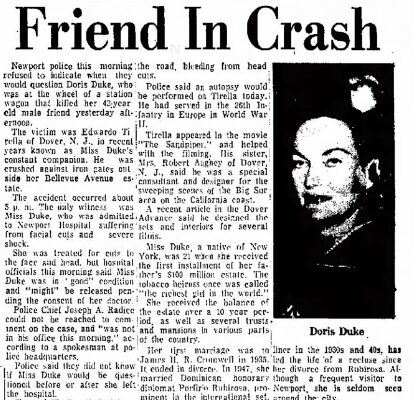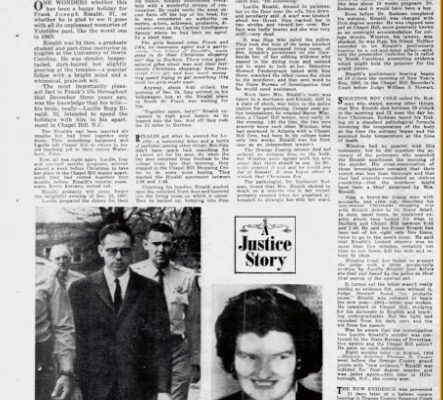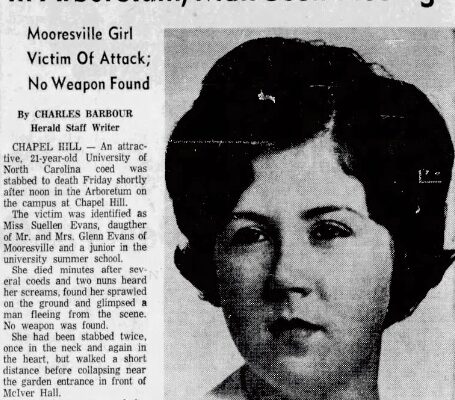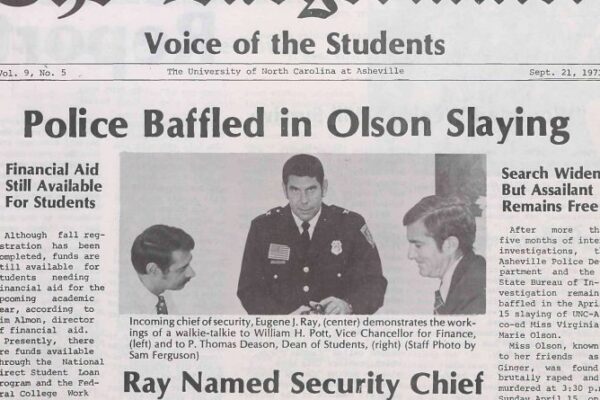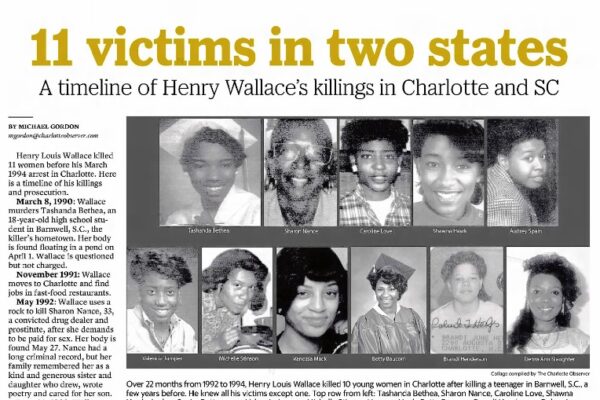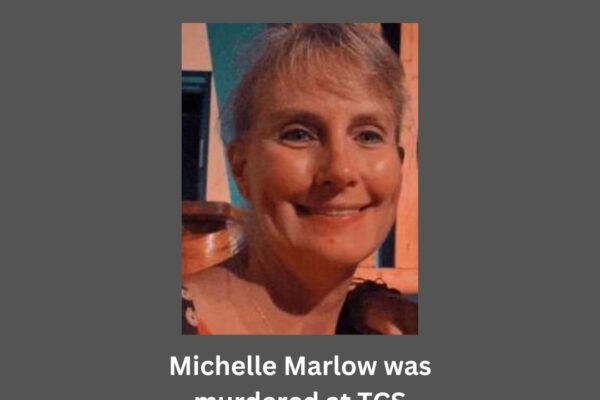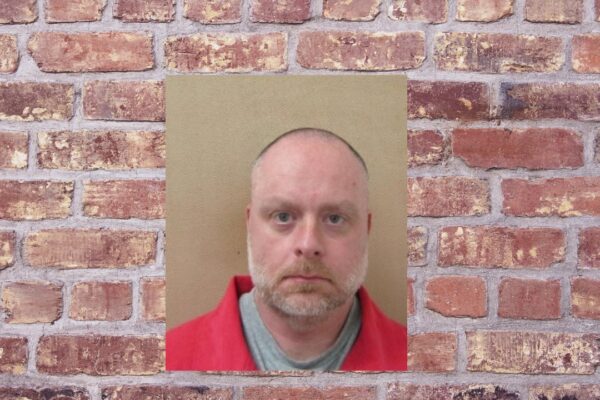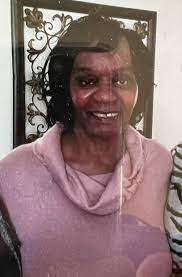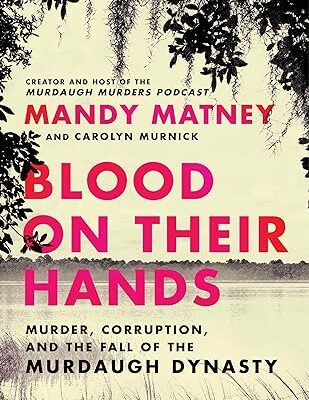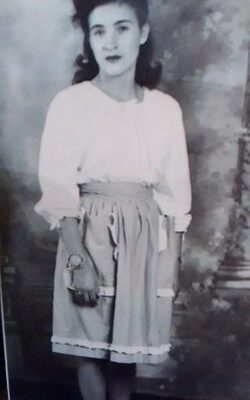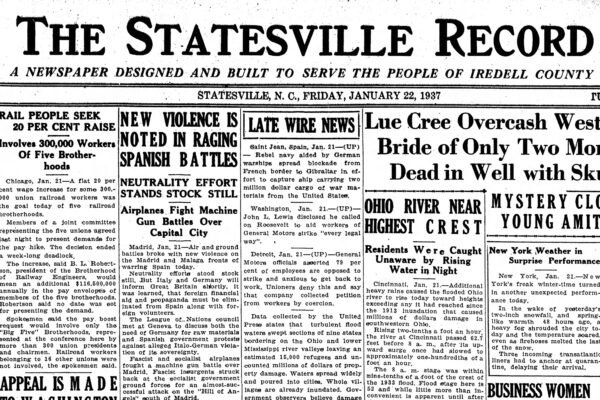For many years, before streaming services became the norm, made-for-tv movies were the bread and butter of network television’s advertising revenue. Those networks often relied on true crime books and journalists to help find ideas for their latest projects. In the case of the state of North Carolina, there have been many of these network movie events that have featured crimes that occurred here. In fact, I was reading one article where a television producer said they took out all the references of North Carolina in one movie, changing up the names of towns and names of streets. The reasoning? They had filmed several made-for-tv movies within a few years that featured North Carolina and didn’t want our state to come across as looking like a place riddled with crime.
But the fact is, there have been many notable true crime books that have shared cases from here. In Episode 53, “Murdered for Money,” I discussed the Russ Stager murder from Durham that inspired the true crime book, “Before He Wakes.” That was the basis for a fictionalized tv movie that ran on the Lifetime Movie Network in 1998, although a lot of the details were changed. Here we’ll take a look at four other crimes from North Carolina that were turned into television projects, including some that broke network viewing records and earned Emmys.
Jeffrey MacDonald
One of the most intriguing cases from North Carolina involves a man named Jeffrey MacDonald. MacDonald had attended Princeton University on a scholarship and then Northwestern University for medical school. He married his high school sweetheart, a woman named Collette Stevenson, before becoming a surgeon in the 6th Special Forces Group in the United States Army stationed at Fort Bragg in 1969. On the night of February 17, 1970, MacDonald, who was 26 at the time, awakened to a real-life nightmare. As he later told the military police, around 2 or 3 a.m., he woke up from where he was sleeping on the living room couch to the sound of screams.
There, he saw two white men, a black man, and a white woman with long blonde hair and a floppy hat in the living room with him. He said the woman was holding a candle and said, “Kill the pigs. Acid is groovy.” He said he fought with the intruders and was hit over the head with a baseball bat. He also sustained an injury to his chest from an ice pick. He then lost consciousness.
Collette MacDonald, also 26, had been stabbed to death in the master bedroom. She was four months pregnant. Five-year-old Kimberly and two-year-old Kristen had also been brutally murdered. During the investigation police found a knife in the master bedroom, a blood-stained baseball bat, ice pick, and another knife in the backyard. Someone wearing gloves had written the word “pig” in blood on the headboard of the bed. An article that ran in the Feb. 19, 2020 issue of The Fayetteville Observer noted that at the time of the murders, Fort Bragg was an open post, meaning there were no security gates or checkpoints to stop anyone from entering the base as they pleased.
The Manson Connection
The crime was even more chilling given that the Manson murders had occurred in California only six months earlier. The community was shaken, and pawn shops all over the area sold out of rifles and handguns as people fearing they would be the next victims tried to protect themselves. Investigators noted that MacDonald’s injuries were far less severe than those of his murdered family. Collette had been stabbed at least 37 times. Investigators also said the living room, where the Green Beret had allegedly fought off four different attackers, seemed staged and not as disorderly as one would have thought. The Army charged MacDonald with homicide on May 1, 1970, and began what is known as an Article 32, or pretrial hearing. It ran from July 6 to September 11 of 1970. During this hearing, the following information was revealed. Seventeen-year-old Helena Stoeckley of Fayetteville, who was a drug addict and police informant in the local community, had made comments about Jeffrey MacDonald to the Fayetteville police officer she worked with. While her statements were vague, because she claimed she was high on the night of the murders, they possibly implicated her as being present at the crime scene. She was known to have worn a blond wig, boots, and a large, floppy hat. In October of 1970, the Army dropped all charges against Jeffrey MacDonald. He left the military at the end of that year, moved to California, and attempted to restart his medical career.
Colette MacDonald’s family initially believed Jeffrey MacDonald’s story, but over time they became more convinced he was guilty. Her stepfather lobbied authorities to keep the investigation alive. In January 1975, a federal grand jury indicted Jeffrey MacDonald for the murder of his family. The trial ran from July 19 to August 29, 1979. When true crime author Joe McGinnis interviewed some of the jurors after the trial, they said when they listened to a recording of a law enforcement interview with MacDonald from April 1970, they had the gut feeling he wasn’t telling the truth. Investigators also used the different blood types of MacDonald, Collette, and the children to show where their blood was found throughout the apartment. It appeared to paint the picture that MacDonald had moved from room to room to commit the murders. The prosecutors also presented articles from Esquire Magazine about the Manson murder case in California. The magazine had been found with blood smeared on it in the MacDonald’s living room. This article told how the word “pig” had been written in blood on a door with actress Sharon Tate’s blood. MacDonald was found guilty of second-degree murder in the deaths of Colette and Kimberley and first-degree murder in the death of Kristen. He received three life sentences.
Jeffrey MacDonald continued to appeal his conviction over the years. He was freed for several years after the 4th Circuit Court of Appeals ruled his right to a speedy trial had been violated. But then the Supreme Court reversed the ruling in March 1982, sending him back behind bars.
True Crime Notoriety
In 1983, author Joe McGinnis published the true crime book “Fatal Vision,” which concluded that MacDonald was guilty and inspired a miniseries of the same name that ran on NBC in November of 1984. Actor Gary Cole played Jeffrey MacDonald and Karl Malden played MacDonald’s father-in-law, Freddy Kassab. Eva Maria Saint and Andy Griffith were other notable co-stars. The miniseries received five Primetime Emmy Award nominations, including Outstanding Drama/Comedy Special. Karl Malden won Outstanding Supporting Actor in a Limited Series or a Special.
Upon MacDonald’s request, Joe McGinnis had worked closely with MacDonald and had access to all the evidence presented during his trials. The author even lived at MacDonald’s home in California while he was behind bars at one point. But when the time came to turn in the completed manuscript, he would not let MacDonald see an advance copy. There was a reason for that. In the book, he asserted that he believed MacDonald was guilty of the murder of his family, and had a psychotic episode while taking a diet pill that got taken off the market in the late 1970s because of troubling side effects. MacDonald felt betrayed, and ended up suing the author in civil trial that resulted in a settlement. The podcast “Morally Indefensible,” produced by truth media, describes the tumultuous relationship between the convicted murderer and the true crime author, and explores whether or not McGinnis acted unethically during the research process of the book.
In 2012, Errol Morris published “A Wilderness of Error: The Trials of Jeffrey MacDonald,” which focused on alleged errors in the MacDonald investigation. Filmmaker Marc Smerling explored new evidence in a series by the same name that originally ran on the FX Network.
MacDonald, now 79, is housed at a medium-security federal prison in Cumberland, Maryland.
Susie Newsom Lynch and Fritz Klenner
On June 3, 1985, the explosion of a moving vehicle rocked the small North Carolina community of Summerfield. It was the culmination of a contentious divorce and family feud that left the Piedmont Triad in disbelief. The story begins with a woman named Susie Newsom, who grew up in Winston-Salem, the daughter of R.J. Reynolds executive Bob Newsom. She was named after Susie Sharp, her maternal aunt who had the distinction of being the first female North Carolina Supreme Court Justice. She attended Wake Forest University, where she met Tom Lynch, who she would eventually marry. He became a dentist and they moved to Albuquerque, New Mexico, where Susie gave birth to two sons. When the couple separated, Susie made the decision to move back to North Carolina to be closer to her family. She and Tom fought bitterly over custody of their young children. Once back in North Carolina, Susie reconnected with a man named Fritz Klenner, a first cousin who was known in the community for embellishing the truth and posing as a medical student. He also must have been the type of person skilled at manipulating others. Despite their blood relation, the two became romantically involved.
Murder in a Kentucky Home
On July 22, 1984, Dolores Lynch and 39-year-old Janie Lynch, Susie’s former mother and sister-in-law, were found murdered in Dolores’ home in Kentucky. They had been shot to death at close range. Susie’s sons were only days away from a scheduled visit with their grandmother. Police were stumped and thought it looked like a professional hit. A year later, Fritz Klenner persuaded a 21-year-old Reidsville man named Ian Perkins to assist in “taking out communist drug traffickers” for the CIA. Ian believed he was auditioning for a position with the CIA, so he drove Fritz to Winston-Salem, where Susie’s parents and grandmother lived. They were murdered that evening in the Newsom home. Police began connecting the dots and realizing the murders of Dolores and Janie Lynch in Kentucky and the Newsoms shared one common thread—Susie Lynch. They questioned Ian Perkins, who admitted driving Fritz to a location a half mile from the Newsom murders and helping dispose of evidence after the fact. He even wore a wire and recorded three separate conversations with Fritz. On June 3, 1985, Fritz told Ian he would write down that Ian believed he was on a covert mission for the government and had no knowledge of the real facts.” Then he said, “I’ve got things to do, I won’t see you again.”
An Explosive Ending
Law enforcement followed Fritz to an apartment where Susie was living, and watched him load his Chevy Blazer with camping equipment, along with Susie, her two sons who were 9 and 10 at the time, and their pet dog. Police attempted to pull the Blazer over, but Fritz fired a machine gun at them and took off. He pulled over on N.C. 150 a few miles later and fired the machine gun a few more times, before the car exploded. Fritz had detonated an explosive device that blew the vehicle apart. Thirty-nine-year-old Susie was thrown from the car, deceased, along with 32-year-old Fritz, who lived for a few minutes before dying as police tried to question him. The boys and dog were found deceased inside the remains of the Blazer. An autopsy later confirmed Susie’s sons had been poisoned with cyanide before being shot. They were never able to determine who murdered the boys before the car explosion.
The motive for all these murders has never been clear. A police seargeant in Kentucky said Tom Lynch was the heir to his mother’s estate, and perhaps Susie was trying to get her hands on part of it as part of the divorce and custody battle. Forsyth County Sheriff Preston Oldham said the following, “Was it their blood relationship? Was it the child custody case? Only God knows, because everybody’s gone.”
Jerry Bledsoe, was a regular columnist for the Greensboro News & Record, put his regular column aside when editors asked him to write about the family murders. He eventually produced an eight-part, 65,000-word series over the course of 11 weeks. He explored the relationship between Susie and Fritz, who had idolized his father, a medical doctor who had gained a reputation for promising cures to patients with massive vitamin injections. The elder Klenner also had a fascination with guns and right-wing politics, which distanced him from relative N.C. Supreme Court Justice Susie Sharp. Bledsoe peeled back more layers, discovering Fritz Klenner failed to graduate from college due to one course, but told people he was a medical student at Duke University. Susie was angry with her husband for having an extramarital affair (he later married the girlfriend) and schemed with Fritz over how best to punish Tom Lynch. Bledsoe turned his research for the investigative series into a New York Times-bestelling novel titled “Bitter Blood: A True Story of Southern Family Pride, Madness, and Multiple Murder.” He called the final act of Susie Newsom Lynch and Fritz Klenner “The ultimate explosion of family pride. Every day you read about where somebody’s gone beserk and shot a bunch of people,” he said upon the book’s release in 1989. “We don’t deal with problems in the south because we’re afraid people will find out about them and think less of us.”
Tom Lynch ended up filing a suit requesting he receive Susie Lynch’s share of his children’s estate, claiming she helped her cousin, Fritz Klenner murder her grandmother, parents and children. The papers Tom filed sought to disqualify Susie Lynch from any share in the family estates and disqualify her brother, Robert Newson III, from any share in her estate. The suit also asked that the children’s estates be included in the distribution of the Newsoms’ estates. Robert Newson III denied his sister was involved in the murders of their parents and grandmother. “The death of my sister and her children is directly attributable to Fritz Klenner and Fritz Klenner only. There is nothing she could have done to save the lives of any of them.” An article that ran in the April 5, 1987 edition of The Charlotte Observer, April 5, 1987 said that although Susie Lynch was a suspect in the Newsom’s deaths, investigators never found evidence she was involved. They did find ammunition residue on her hands at the crime scene, indicating she had fired a weapon just before the explosion.
The case went to trial in the fall of 1990. Tom Lynch told the media that he pursued the civil case more for answers than for monetary compensation. “I did this because of a promise I made to my sons after they died. That’s the main reason I did it. I wasn’t much interested in money as in ferreting out the truth and finding out who was responsible. Susie’s brother, Robert Newsom III, confirmed in early January 1991 that he had reached an agreement in principle with Tom Lynch. The case was settled out of court for an undetermined amount of money. At the time of her death, Susie Lynch’s estate was estimated at around $400,000. In another article, Tom Lynch discussed how he believed the picture of what happened during the course of the nine deaths was much clearer. He no longer believed Susie had murdered their sons, rather, Fritz had been responsible for it. Lynch did feel law enforcement had dropped the ball during the course of the investigation. That didn’t mean Susie wasn’t an accessory, though. Lynch’s attorney, an ex-FBI agent named Arthur Donaldson, said he believed both sides won in the case. “It was a no-win situation for both sides,” he added. “When they settled, they both won.”
In 1994, CBS aired a made-for-television movie based on the case called “In the Best of Families: Marriage, Pride, and Madness.” It starred Kelly McGillis as Susie Newsom Lynch, Harry Hamlin as Fritz Klenner, and Keith Carradine as Tom Lynch.
Timothy Hennis, Guilty or Innocent?
The case of Timothy Hennis and the Eastburn family that also took place in Fayetteville, North Carolina has been one similar to the Macdonald case because it has spent decades in and out of the court system. It’s one of those cases that still doesn’t seem to have a resolution after 37 years and has left many with questions about double jeopardy and our country’s legal system. On Mother’s Day of 1985, the bodies of a 31-year-old military spouse Kathryn Eastburn and her two young daughters were found brutally murdered in their home. Kathryn had also been sexually assaulted. Another daughter, a toddler, was unharmed but had lived in the home alone for several days after the murder. Kathryn Eastburn’s husband, Gary, a U.S. Air Force Captain, had been away in Alabama for military training. The Eastburns had been planning to relocate out of the country and had placed an ad in the newspaper seeking to rehome their family dog. A few days before the murders, 27-year-old Timothy Hennis, a soldier at nearby Fort Bragg, stopped by the home to meet the pet. When he heard news reports that police were looking to talk to someone who had answered Kathryn Eastburn’s newspaper ad, he voluntarily went to police headquarters.
A witness had come forward saying he was near the Eastburn home on the night of the murders, and saw a tall white male wearing jeans, a knit cap, and a Members Only jacket leaving the home around 3:30 in the morning carrying a garbage bag. A police artist drew a sketch based on that description. When the police put Timothy Hennis in a line-up, the witness identified him as the man near the crime scene. He was arrested for the murders, and went on trial in 1986, where a series of circumstantial evidence was presented to a jury.
Motive: Lust and Greed
Hennis was married at the time of the murders and had an infant with his wife. She was out of town, and prosecutors theorized he went to the Eastburn home looking for sex. When Kathryn Eastburn refused, he murdered her and two of the children by stabbing them so they couldn’t be witnesses. There were several items missing from the home after the murders, including an envelope of money, an ATM card, and the Eastburn account password. Timothy Hennis had been behind on his rent, which was about $300. On the Monday after the murders, he paid the rent in full. A woman who used the same bank ATM after the Eastburn’s ATM card was used identified Hennis as being there withdrawing cash. Prosecutors also showed the jury a series of gruesome crime scene photos as part of their case. Hennis was found guilty, and sentenced to death. This was only the beginning of his story, though.
According to an article about the case that ran on CNN titled “Triple murder suspect goes from guilty to innocent and back to guilty,” his attorneys appealed his case to the North Carolina Supreme Court, where judges ruled the graphic crime scene photos wrongly influenced jurors to render a guilty verdict. He was granted a retrial. His attorneys then focused on debunking the circumstantial evidence that had been presented at the first trial. A new witness came forward who said he had been walking in the neighborhood at the time of the killings. He often wore the exact same outfit the defense witness had claimed to see and had a habit of walking through the neighborhood in the early hours of the morning when he couldn’t sleep. This presented reasonable doubt, and Timothy Hennis was acquitted. He re-enlisted in the Army, retiring in 2004 as a master sergeant. Prosecutors continued to collect evidence, though. They ran vaginal swabs collected from Kathryn Eastburn at the time of the murder and ran them against Timothy Hennis’s DNA, where they got a match. At this point, the U.S. Army decided to pursue the case through their legal system. This was not considered double jeopardy because a different prosecutor in a different court system was taking over the case. Hennis was found guilty in 2006 and sentenced to death.
In 2011, a military judge denied Timothy Hennis’s request for a fourth trial. His attorneys had argued that the North Carolina State Bureau of Investigation Crime Lab could have skewed their lab results from the semen swabs. At the time, the director had admitted the agency did not always automatically provide complete crime lab test results for use in trials.
Reporter Scott Whisnant, who covered the case and wrote the true crime book, “Innocent Victims,” told CNN there is still physical evidence pointing to another suspect that can’t be explained. For example, unidentified DNA was found underneath Kathryn Eastburn’s fingernails. There was a head hair found in the Eastburn’s bed that was not Timothy Hennis’s.
Timothy Hennis is currently on death row in Fort Leavenworth, Kanasas, but cannot be executed without presidential approval. The last time the U.S. Military executed anyone was 1961.
In 1996, ABC adapted the book into a miniseries titled “Innocent Victims.” Actor John Corbett portrayed Timothy Hennis, with Hal Holbrook and Rue McClanahan playing his parents, and Rick Schroder in the role of one of his attorneys.
The Murder of Leith Von Stein
And finally, let’s discuss the 1988 murder of Leith Von Stein that was perpetrated by a young man named Chris Pritchard, who was then a student at North Carolina State University. I found the following background information on the family in an article that ran in the Winston-Salem Journal on January 29, 1990. Chris Pritchard grew up in North Carolina, the son of a woman named Bonnie Bates and Steve Pritchard. His father left the family not long after Chris’s younger sister Angela was born. He and his mother and sister then moved in with his maternal grandparents on their farm in Lexington, North Carolina. Bonnie went back to school to study computers, eventually taking a job in the data-processing division of Integon Corp. in Winston-Salem in 1974. While working there, she met a man named Leith Peter Von Stein. Leith ran the data-processing department. His parents had started up a successful dry cleaning business called Camel City Cleaners. Bonnie’s parents quickly took to Leith and felt he was a good match for their daughter. Bonnie and Leith were married in 1978. The family moved to South Bend, Indiana when he took a job there. In 1981, they made the move back to North Carolina when Leith took a job as the director of internal audits for the National Spinning Co. in Washington. Chris and Angela attended school at Washington High School. When he was a senior in high school, Leith’s parents passed away, leaving him over a million dollar inheritance. It doubled his net worth at the time. Leith adjusted his will to make sure Chris and Angela would be provided for in the future.
A Dangerous Game
After graduation, Chris headed off to North Carolina State University in Raleigh in a classic 1965 Ford Mustang his step-father Leith had gifted him. Once there, he joined a group of students who preferred taking LSD and playing Dungeons & Dragons. His failing grades that first year caused conflict at home. At the end of the year, Leith confronted him and expressed his disappointment at Chris’s academic performance. The fight stopped short of anyone throwing blows. Around that time, Chris began talking to a few of his friends at N.C. State, Neal Henderson and James “Bart” Upchurch about a plot to murder his parents. Chris and Bart had grown up together in Caswell County, been in Boy Scouts together, and attended the same high school. Neal Henderson was an academically-gifted student from the North Carolina School of Science and Math who had trouble finding a social circle he fit into. The role-playing game gave him a sense of belonging. I’m assuming his sister Angela was also intended to be a victim in the plot because otherwise, Chris would have had to split his inheritance with her. He wanted to leave school, not have to worry about working, and buy a fancy house for himself and friends in Raleigh. He told the two classmates he would give them each $50,000 and a Porsche for Neal and a Ferrari for Henderson.
On July 24, 1988, the young men devised their first plan to stage accidental deaths for Chris’s family by planting a broken fuse in the electrical box, dousing the wall with gasoline, and setting a fire. Chris even went so far as to lace a meal of grilled burgers with a sleeping aid while he was home visiting. However, Neal and Bart lost the fuse as they were trying to crack it in the door of Chris’s car trunk. Their next idea was to send one of the men into the home with a machete. That scheme was aborted when the nearby Army-Navy Surplus Store was closed. But Chris Pritchard would not be deterred. He purchased a hunting knife from a K-Mart department store in Raleigh, planning to have Bart enter the house with Chris’s key, stage a break-in, and attack Chris’s parents while they slept with the weapon and a baseball bat. He drew them a map of the house, so they knew the layout. Bart stayed behind in Raleigh at the dorms to establish an alibi. Neal drove Bart the 100 plus miles to Washington, where he dropped his friend off near the house. When Bart returned, he was covered in blood, confessing he had gone through with the plan. They then attempted to destroy the evidence, get rid of Bart’s clothing, and wash the car.
Bonnie Von Stein, age 44, survived the attack and was able to call 911. Her husband Leith, age 42, was pronounced dead at the scene. Angela was asleep in her bedroom and was not harmed. With Chris’s mother and sister still alive, his plan did not go the way he intended. But investigators had a hard time figuring out who the perpetrators were. When they found a part of the burned map Chris had drawn for his friends, they recognized Chris’s handwriting. They had no other evidence linking him to the crime, though. By then, Chris and his mother Bonnie, who had debilitating injuries from the stabbing, had moved back to Winston-Salem to be closer to family. It was Neal Henderson who helped move the needle for justice. After the murders, he left N.C. State and was working as an assistant manager at a Wendy’s restaurant in Virginia. Unable to hold the secret any longer, he went to authorities and confessed his role in the murder.
Pointing Fingers
When Chris Pritchard, Neal Henderson, and James Bart Upchurch were arrested in June of 1989, Bonnie Von Stein could not believe her son was involved in the murderous plot that resulted in the death of her husband. But once Chris admitted his role to her, she had no choice but to believe it, stating publicly that the drugs he had become addicted to must have influenced him.
Chris and Neal reached a plea agreement with the prosecutors. They pled guilty to conspiracy to commit murder so they wouldn’t have to face first-degree murder charges. They both testified in Bart Upchurch’s trial, which was moved from Washington to Elizabeth City due to pretrial publicity. His attorneys claimed he was framed for the murder by his two friends. But prosecutors said a green backpack found at the Von Stein’s home was identified as belonging to Bart. The baseball bat he took to the crime scene was found at his home and identified by Neal Henderson. In court, Neal Henderson said, “What they proposed to me, it seemed like an adventure, just go off in the middle of the night and come back . . . But up until (Upchurch) got out of the car with the weapons, I didn’t fully believe he would do it.”
A jury found Bart Upchurch guilty and he was sentenced to death, but that was later commuted to life in prison, where he remains today. His most recent parole hearing was in 2022. Gerald Henderson was sentenced to 40 years in prison for aiding and abetting a first-degree murder, plus a six-year-sentence for aiding and abetting assault with a deadly weapon with intent to kill and inflicting serious injury. He was paroled in December of 2000. Chris Pritchard received a life sentence for second-degree murder and an additional 20-year-sentence for the attack on his mother. He was paroled in June of 2007 and, according to his LinkedIn profile, assists formerly incarcerated people to overcome the challenges of re-entry into society.
He told Fox 8 WGHP-TV “I knew what evil I had done. The only thing I had to cling to was the lie I had told to begin with,” Chris said. “I’m the biggest number one sinner that there is. But God’s grace is enough even for that.”
In 1991, North Carolina author Jerry Bledsoe wrote a book about the case titled “Blood Games: A True Account of Family Murder.” The following year, CBS adapted the book into a TV movie titled “Honor Thy Mother.” Actress Sharon Gless played Bonnie Von Stein and William McNamara was Christopher Pritchard. In 1992, true crime author Joe McGinnis wrote his own book about the case titled “Cruel Doubt.” This was turned into a TV miniseries that ran on the NBC network, and it starred Blythe Danner as Bonnie Von Stein and Gwyneth Paltrow as her daughter Angela.
Case Sources:
Jeffrey MacDonald
https://www.imdb.com/title/tt0087244/
https://www.nacdl.org/Article/May2013-ReflectionsontheJeffreyMacDona
https://podcasts.apple.com/us/podcast/morally-indefensible/id1525749557
Susie Lynch and Fritz Klenner
The Charlotte Observer, July 9, 1985
“Accessory Suspect Faces Trial July 20”
https://www.newspapers.com/image/624539730
The Charlotte Observer, April 5, 1987
“Slain Boys’ Father Seeks Estate Share”
https://www.newspapers.com/image/632610209
The News and Observer, Aug. 21, 1988
“Family pride and mass murder (book review)”
https://www.newspapers.com/image/655865784
The Herald-Sun, Oct. 9, 1988
https://www.newspapers.com/image/788850231
The Charlotte Observer, Jan. 3, 1989
“The Ultimate Explosion”
https://www.newspapers.com/image/625955306
News and Record, Jan. 3, 1991
“Lynch case finally nears its end”
https://www.newspapers.com/image/943977900
Statesville Record and Landmark, June 3, 2021
https://www.newspapers.com/image/739910097
The Charlotte Observer, June 4, 2021
“Cousins in love, a trail of murder: An infamous NC couple who died in a car blast 36 years ago”
https://www.newspapers.com/image/739937126
Timothy Hennis
The Asheville Times
May 18, 1985
“Sergeant Has First Hearing on Murder Charges”
https://www.newspapers.com/image/944766977/?terms=Timothy%20Hennis&match=1
The Charlotte Observer
May 22, 1985
“Oil Drum, Jacket Seized as Clues”
https://www.newspapers.com/image/623972361
The News and Observer
February 5, 2011
“Military judge denies Hennis’ bid for 4th trial”
https://www.newspapers.com/image/649360501
Leith Von Stein
Winston-Salem Journal, July 27, 1988
“Former City Resident is Stabbed to Death in Washington, N.C.”
https://www.newspapers.com/image/940006941
Winston Salem Journal, Jan. 29, 1990
https://www.newspapers.com/image/940735532
Pact
News and Record, Jan. 28, 1990
https://www.newspapers.com/image/943703455
Defendant Was Framed, Attorneys Say
The Charlotte Observer, January 23, 1990
https://www.newspapers.com/image/625727639
Chris Pritchard Story Fox8 WGHP-TV
Killer Gets Death; Vows Hunger Strike
News and Record
Son Wanted Inheritance Students Act Out Fantasy Game Scenario in Real-Life Murder
http://www.theescapist.com/archive-pritchard01.htm




